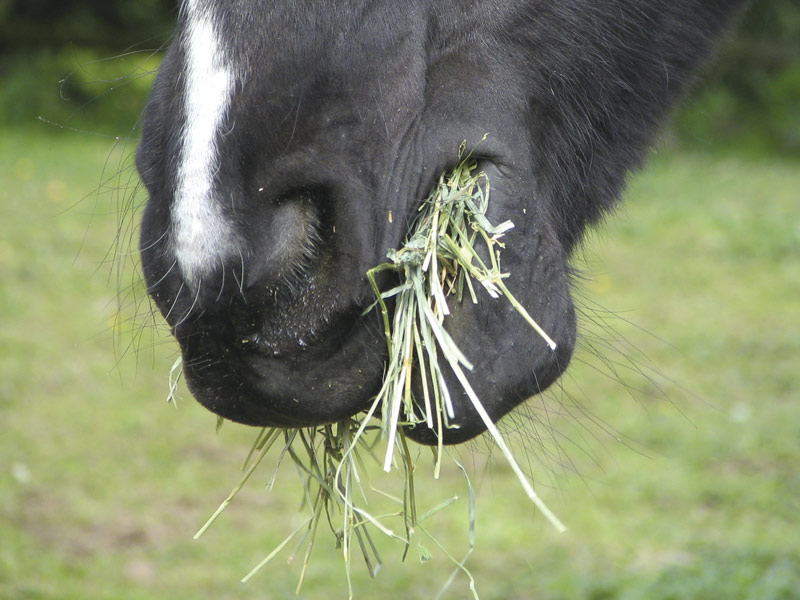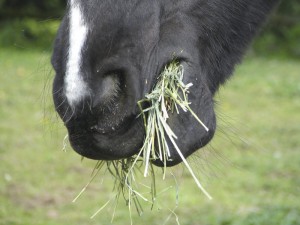The Slow Feeding Movement

 It’s rapidly gaining in popularity, and no wonder. These tips will get you started and help you select the best slow feeder method for your horses.
It’s rapidly gaining in popularity, and no wonder. These tips will get you started and help you select the best slow feeder method for your horses.
The slow feeding movement has come a long way in the last several years. Many horse owners and veterinarians are now familiar with the concept. Today’s market offers a range of nets in various sizes as well as solid feeders with grates, so you have a wide array of options to choose from.
“Seven years ago, I was really a pioneer, and there were very few other options available,” says Melissa Auman, President of Horses of Course and manufacturer of Freedom Feeder nets. “It has been satisfying to see the movement expand and become more mainstream.” This sentiment is echoed by Erin Olson, owner of Hay Chix: “When we started out as Cinch Chix in 2009, there was a lot of skepticism, but now that the concept has been proven with research and customer satisfaction, the concept of slow feeding has become more commonplace.”
UNDERSTANDING GRAZING BEHAVIOR
Despite growing acceptance, there are still many people who are not familiar with the idea of slow feeding, or else consider it something for easy keepers only. In fact, the majority of stall and dirt lot kept horses can benefit from this feeding approach.
In their natural setting, horses would be eating for about 14 to 16 hours a day, so they constantly secrete stomach acid whether they are eating or not. While chewing, they release saliva, which is high in bicarbonate and calcium – both are buffers, helping to keep the stomach’s acidity in check.
Today, many horses have limited access to forage and therefore spend much less time eating and creating saliva. Meanwhile, acid release goes on; less forage in the stomach combined with reduced buffering increases the risk of gastric ulcers. The risk of other health conditions, such as colic and behavioral issues like wood chewing, cribbing and stall walking, is also increased due to modern day feeding management practices.
When grazing naturally, horses eat only a few blades of grass at a time, using their lips to work the blades into their mouths. This is identical to how horses work hay out of a small-hole slow feeding net. “Really, it’s like pasture in a net,” explains Melissa. “When horses are given hay loose in feeders or on the ground, they take in large mouthfuls at a time. The nets simulate natural grazing behaviors. I hear from owners all the time that when given the choice, their horses prefer to eat from a net versus eating loose hay. Clearly, something about it feels right to them.”
THE SCIENCE BEHIND SELECTING A SLOW FEEDING NET
In a study from the University of Minnesota, published in the Journal of Equine Veterinary Medicine in 2014, researchers investigated the impact of various hay net hole sizes on the rate of hay consumption. Horses were fed 1% of their body weight in mostly grass hay at 7am and 4pm, either loose on the fl oor or from hay nets with large (6”), medium (1.7”) or small (1.3”) openings. The horses were found to consume 95%, 95%, 89% and 72% of their hay (for each of the four scenarios respectively), within four hours. Most of the horses being fed from the medium and small nets were unable to finish their hay within the four-hour testing window. In other words, rates of intake gradually decreased with decreasing hole size, with those eating from the small hole net consuming 2 lbs of dry matter per hour versus 3.3 lbs per hour for the horses fed loose hay. When allowed to eat from medium and small hole nets until all hay was consumed, horses took 5.12 and 6.5 hours respectively, versus the control and large hole net groups, who finished their hay in 3.1 and 3.4 hours.
At the start of the trial, some of the horses shook and bit at the nets, suggesting a level of frustration. This observation led the researchers to caution that nets with medium and small holes may not be suitable for horses with little incentive to eat, since the frustration of getting the hay out of the net may discourage them from eating.
With this in mind, Erin and Melissa have recommendations on how to introduce horses to slow feeding nets.
“When feeding a group of horses together, I recommend selecting an introductory hole size that will avoid frustration in the least motivated horse in the group,” explains Erin. “With our nets, people can typically start out with the 1.75” hole nets, unless they have horses that will not work for food, such as some seniors. I then recommend selecting nets with 2.5” holes. Over time, as the easily frustrated horses learn to adapt to the nets, the size of the holes can be reduced.”
The research from University of Minnesota found that, on average, it takes four feedings for horses to feel comfortable eating from the nets. Both Erin and Melissa recommend using the nets initially as a source of additional hay.
“I recommend that owners feed their regular hay just as they have been doing, loose on the ground or in regular feeders, and provide additional hay in slow feeders,” says Melissa. “Once a horse is choosing to eat hay in the net and is leaving the loose hay, the latter can be removed.” These measures will go a long way to reducing frustration and ensuring success.
When using nets in a group setting, it is important to always set out more nets than there are horses; this has the added benefit of encouraging movement.
THE BENEFITS OF SLOW FEEDING
The advantages of using slow feeders go beyond the potential impact on a horse’s health. A reduction in waste is common since the hay is less easy to distribute and therefore less likely to be trampled, urinated or defecated on. Feeders are available for entire bales, which can cut down on time spent feeding. In fact, moving towards what some term “restricted free access feeding” is perhaps the ultimate goal of slow feeding.
“It really is possible to feed the majority of horses this way,” explains Melissa. “If owners keep their nets full at all times with low calorie high fiber forage, they can retrain their horses to regulate their intake. It takes time for horses to adjust and often owners give up too quickly. They see their horses consuming a large amount of forage, more than they might have when they were meal fed, but this is the horse’s initial response and arises from historically having limited available forage.” Give it time, she advises. “I’ve had owners tell me it has taken their horses from as little as a day to as long as three months to self-regulate, but on average it seems to take about three to four weeks.” Once self-regulated, horses typically eat approximately the same amount of hay as they did when fed in meals, but they consume it slowly throughout the day.
Feeding this way can have unexpected benefits too. Reducing angst around feeding translates to a more relaxed horse, which may lead to a change in work ethic under saddle. For horses kept in groups, less stress changes herd dynamics for the better. And when forage is available, feeding at precise times becomes less important, a nice bonus if you want to sleep in on Saturday morning. “Most of my customers think they are buying their horses freedom, and are surprised when they end up gaining just as much freedom themselves,” laughs Melissa.
A BIT ABOUT GRAZING MUZZLES
For easy keepers or horses with metabolic conditions that require limited sugar consumption, pasture can pose a frustrating challenge. On the one hand, it is the most natural feeding method we have; yet many pastures are too high in sugar or provide too many calories for easy keepers. So how do you reap the benefits that come with pasture turnout while managing your horse’s waistline?
The answer is a grazing muzzle. Found to reduce pasture intake in ponies by as much as 80% (by researchers at the University of Virginia), muzzles do a far better job of restricting intake than limiting turnout time does. It turns out that ponies are just as smart as we guessed; when turned out for less time, they increase their rate of intake, which means reducing hours in turnout doesn’t have the effect we would like. Using a properly fitted grazing muzzle reduces intake while allowing extended periods of pasture time, which offers additional health benefits.
SLOWING DOWN GRAIN AND PELLET CONSUMPTION
Slow feeding isn’t just about hay, though. Slowing down the consumption of other feeds can also be of benefit. When her horse was diagnosed with chronic colitis, Liv Gude, founder of Professional Equine Grooms, made the switch from hay to a completely pelleted diet.
“Initially, it was easy as we were just switching from hay to the same type of hay in a pellet,” Liv explains. However, she was soon witnessing the big issue with pellets, which is that they don’t take as long to eat as long stem hay. “It became apparent that if I wanted to keep forage in front of my horse, I was going to have to feed six to eight meals a day rather than the more typical two or three.” This is not very practical, but there are a number of automatic feeders on the market that dispense pellets or grain at set intervals during the day. A more affordable option is to use a toy such as the Nose-It!® Ball, which the horse has to push along the floor with his nose, allowing pellets to dribble out.
Another affordable option that Liv shares is to put large smooth rocks in the bottom of the feed container. “The horses have to eat around the rocks,” she explains. She cautions that horses like to tip feeders over to speed things up, so the feeder should be secured to prevent this while also preventing a leg from getting caught.
Liv says she hears from grooms who are frustrated with managers who do not want to implement slow feeding practices because they will take too much time. “I think this is short sighted because the opposite is true. Even the smallest of hay nets can hold several flakes of hay, usually good for a full day of chewing. In a barn situation, hanging one day’s worth of forage in the morning is faster (and healthier) than making several trips throughout the day. For barns that feed using a tractor or utility vehicles, you are saving roughly two-thirds of your fuel costs for the day. Using slow feeders also virtually eliminates wasted hay, so you may find that four flakes of hay on the ground is equivalent to three flakes of hay in a net and more money in your pocket.”
Whatever you feed your horse, there are many options you can use to help your horse mimic a more natural eating style. Doing so honors the anatomy and physiology of his digestive tract and will help keep problems such as colic, ulcers, obesity and laminitis at bay while potentially giving you more free time and even saving you money.
